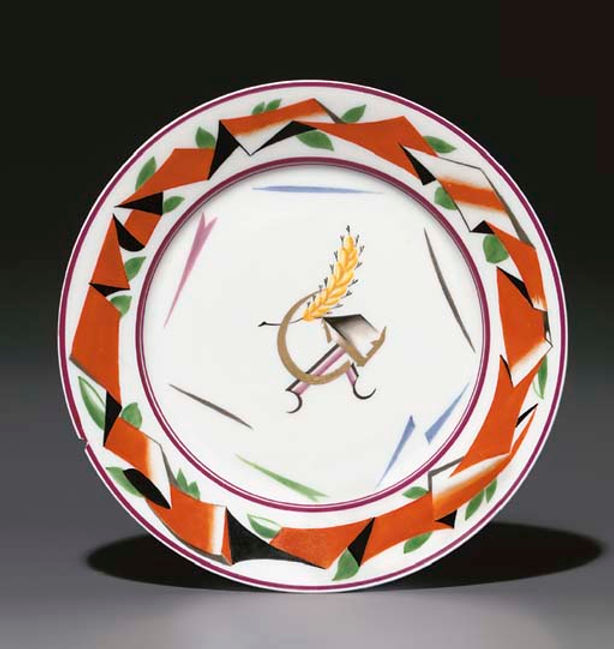By: Zhaohua Chen
Elegant porcelain pieces of chess are slid across the table, where they are carefully inspected and glazed over. They’re unlike any other chess pieces ever discovered, dressed in elegant red robes decorated in gold, almost resembling Roman attire, detailed brazen armor, and even simple scraps of cloth. Created by Natalia Danko, a Soviet sculptor and ceramist, these pieces are only a small piece of the sea of ceramic collections made to spread Communist propaganda.
After the communist government was put into place in 1917 under the Bolsheviks, most remnants of the old monarchy lay in crumbling ruins, but one still stood– the Imperial Porcelain Manufactory, located on the outskirts of what is now St. Petersburg. Under a man known as Vladimir Lenin, the Bolsheviks were quickly able to rename it to the State Porcelain Manufactory. Instead of destroying it, they kept it. But why?
At the beginning of their reign in Russia, the Bolsheviks needed a way to make sure all the citizens would follow communism. What better way to do this than to ensure a slew of propaganda would make it into each and every house in their nation? In the plain white china made at the factory, a new and fresh canvas was to be found. This unlikely factory was the beginning of a massive propaganda movement.
The emblem of the Imperial Porcelain Manufactory was removed from all the china, coated with a fresh layer of paint, and replaced by the symbol of a cog, sickle, and hammer. These items served as a reminder to the citizens of Russia that the industrial worker played a large part in the nation’s future. These emblems would eventually make it onto the factory’s future designs and the Soviet Union’s new flag.
These elegant pieces of china, including teapots and other items that were originally made for the luxurious and rich feasts of the nobles and royal family, now carried a much darker message. Glorious battle scenes depicted a military in red, marching and trampling over white furs, and even porcelain chess sets envisioned similar scenes of red overtaking white– communism overtaking the old government to form a paradise.
Much of the work in the factory was done by possibly the most talented artists of the time, including Russian avant-garde artists. Among them were Kazimir Malevich, an abstract and geometric artist whose works expressed a revolutionary pride that interested the Bolsheviks.
Eventually, the pieces of propaganda disguised as art spilled into other aspects of Russian daily life, such as architecture and theater films. Ceramics meshed in with the rest of the propaganda and brought hardworking and underappreciated avant-garde artists joy, seeing their work finally being recognized. Many Russian citizens were also pleased with how much work the factory could give, and during the harsh era after the Russian Revolution, communism’s impact seemed to be a guiding light.
Despite all having a mission of creating artistic propaganda, the artists employed were beyond eager to experiment. Dr. Sjeng Scheijen, an author and Russian art specialist, says, “Most of the time the artists were just looking at the forms and how they could integrate their own extremely revolutionary, abstract language they had developed, into these particular forms.”
However, this creative flow would eventually do more harm than good. The pieces made, though of very high quality, were too rare and experimental. They were of so high quality to the point that it became nearly impossible to efficiently manufacture them. One of Malevich’s creations, a half-moon cup and block-like teapot, was too clumsy to handle and was doomed to sit upon the display shelf.
Despite the revolutionary and propaganda-influenced messages on these ceramics, they ultimately didn’t manage to get further than the display shelves of wealthy aristocratic collectors. This meant that many of the people didn’t get the actual message on the pieces, which was the end goal for the Bolsheviks.
When Joseph Stalin rose to power in the late 1920s, he established a dictatorship where art was used as a means for brutal propaganda. The one thing that distinguished his form of art from his predecessor, Lenin’s, was that Stalin would only let specific works of art be published. Soon, more and more artists began to lower the quality of their creative works just to conform with Stalin’s ideals.
Though the impact of artworks from the socialist wave of 1917 continued to dwindle following large amounts of execution, bloodshed, and famine, the carefully crafted ceramics were kept by modern appreciators of them. And though they did not fulfill their original propaganda purpose, these ceramics brought expressive creations of art to life in a time where it all seemed lost.
Sources: https://s3.amazonaws.com/appforest_uf/f1656880002532x416782483752314900/How%20teapots%20were%20used%20to%20spread%20Russian%20propaganda%20-%20BBC%20Culture.pdf











